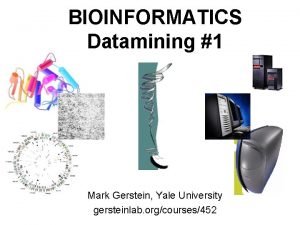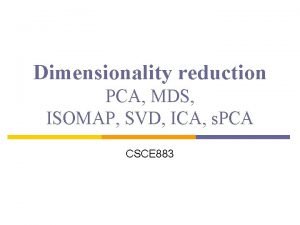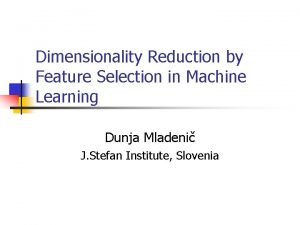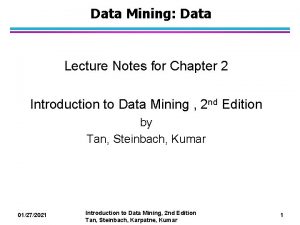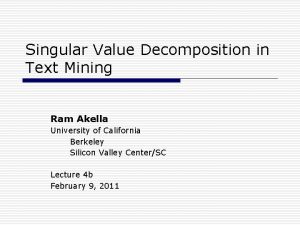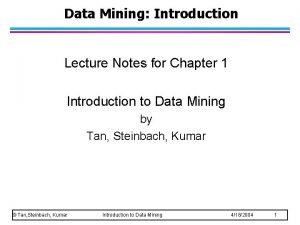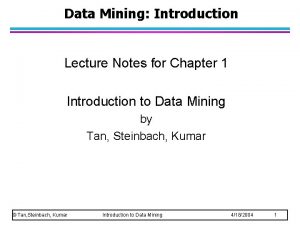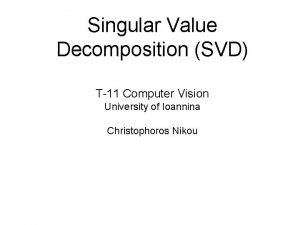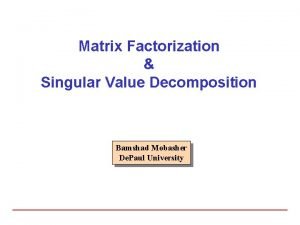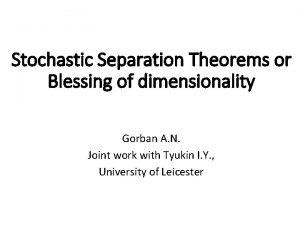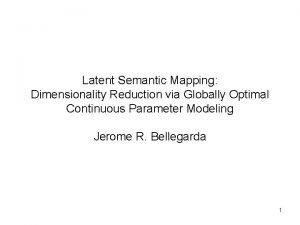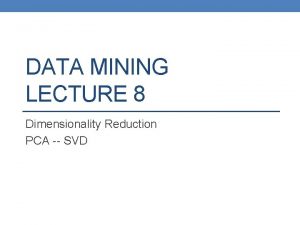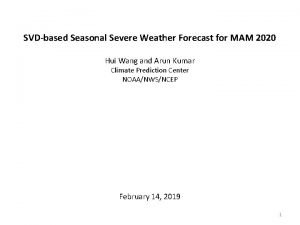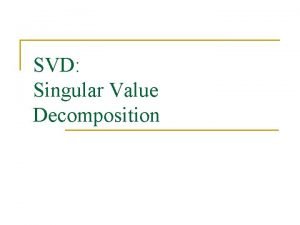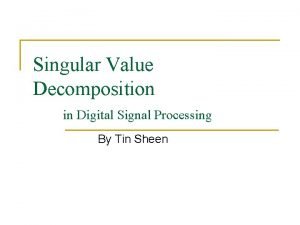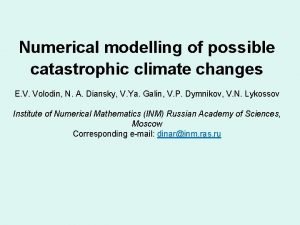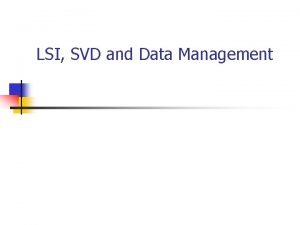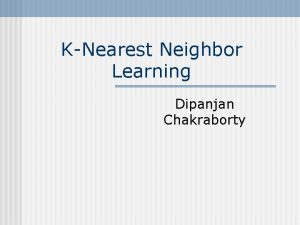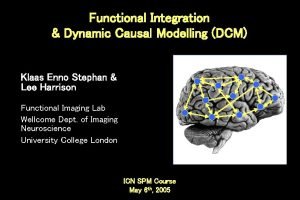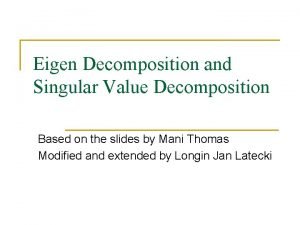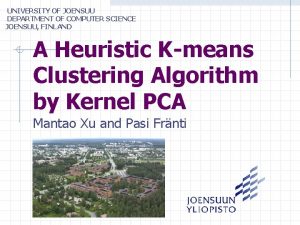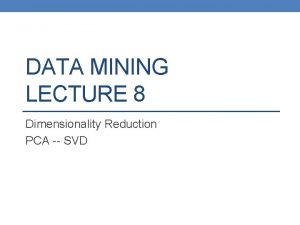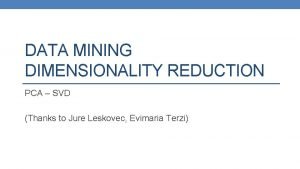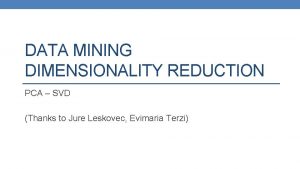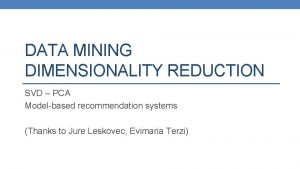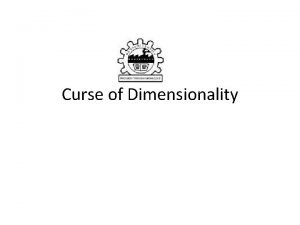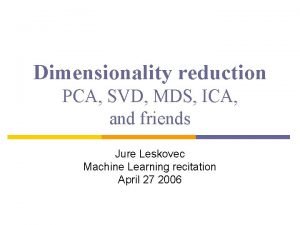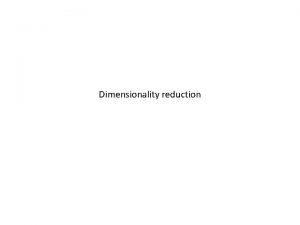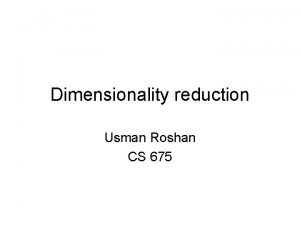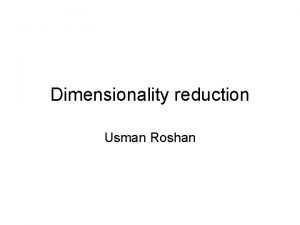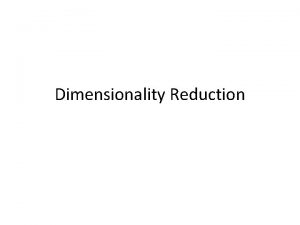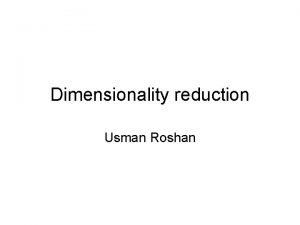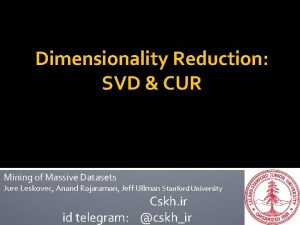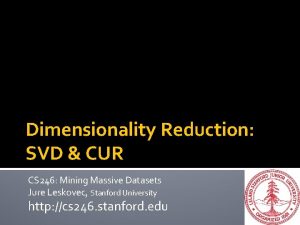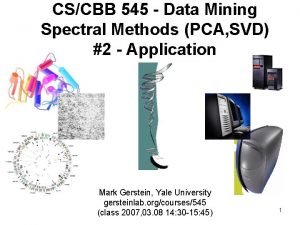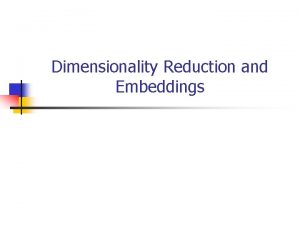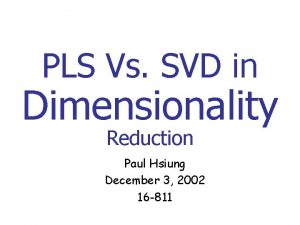DATA MINING LECTURE 7 Dimensionality Reduction PCA SVD

















![Singular Value Decomposition • [n×m] = [n×r] [r×m] r: rank of matrix A Singular Value Decomposition • [n×m] = [n×r] [r×m] r: rank of matrix A](https://slidetodoc.com/presentation_image_h2/a9cadd6a9955d0d66941cc181b784a2c/image-18.jpg)













































- Slides: 63

DATA MINING LECTURE 7 Dimensionality Reduction PCA – SVD (Thanks to Jure Leskovec, Evimaria Terzi)

The curse of dimensionality • Real data usually have thousands, or millions of dimensions • E. g. , web documents, where the dimensionality is the vocabulary of words • Facebook graph, where the dimensionality is the number of users • Huge number of dimensions causes problems • Data becomes very sparse, some algorithms become meaningless (e. g. density based clustering) • The complexity of several algorithms depends on the dimensionality and they become infeasible (e. g. nearest neighbor search).

Dimensionality Reduction • Usually the data can be described with fewer dimensions, without losing much of the meaning of the data. • The data reside in a space of lower dimensionality

Example • In this data matrix the dimension is essentially 3 • There are three types of products and three types of users

J. Leskovec, A. Rajaraman, J. Ullman: Mining of Massive Datasets, http: //www. mmds. org 5 Example • Cloud of points 3 D space: • Think of point positions A as a matrix: 1 row per point: B C A • We can rewrite coordinates more efficiently! • Old basis vectors: [1 0 0] [0 1 0] [0 0 1] • New basis vectors: [1 2 1] [-2 -3 1] • Then A has new coordinates: [1 0]. B: [0 1], C: [1 1] • Notice: We reduced the number of coordinates!

Dimensionality Reduction • Find the “true dimension” of the data • In reality things are never as clear and simple as in this example, but we can still reduce the dimension. • Essentially, we assume that some of the data is noise, and we can approximate the useful part with a lower dimensionality space. • Dimensionality reduction does not just reduce the amount of data, it often brings out the useful part of the data

J. Leskovec, A. Rajaraman, J. Ullman: Mining of Massive Datasets, http: //www. mmds. org 7 Dimensionality Reduction • Goal of dimensionality reduction is to discover the axis of data! Rather than representing every point with 2 coordinates we represent each point with 1 coordinate (corresponding to the position of the point on the red line). By doing this we incur a bit of error as the points do not exactly lie on the line

J. Leskovec, A. Rajaraman, J. Ullman: Mining of Massive Datasets, http: //www. mmds. org 8 Why Reduce Dimensions? • Discover hidden correlations/topics • Words that occur commonly together • Remove redundant and noisy features • Not all words are useful • Interpretation and visualization • Easier storage and processing of the data

Dimensionality Reduction • We have already seen a form of dimensionality reduction • LSH, and random projections reduce the dimension while preserving the distances

Data in the form of a matrix •

Example: Document matrices d terms (e. g. , theorem, proof, etc. ) n documents Aij = frequency of the j-th term in the i-th document Find subsets of terms that bring documents together

Example: Recommendation systems d movies n customers Aij = rating of j-th product by the i-th customer Find subsets of movies that capture the behavior or the customers

Linear algebra •

Matrices •

Rank •

Rank-1 matrices •

Eigenvectors •
![Singular Value Decomposition nm nr rm r rank of matrix A Singular Value Decomposition • [n×m] = [n×r] [r×m] r: rank of matrix A](https://slidetodoc.com/presentation_image_h2/a9cadd6a9955d0d66941cc181b784a2c/image-18.jpg)
Singular Value Decomposition • [n×m] = [n×r] [r×m] r: rank of matrix A

Singular Value Decomposition •

Symmetric matrices •

An (extreme) example • A=

J. Leskovec, A. Rajaraman, J. Ullman: Mining of Massive Datasets, http: //www. mmds. org 22 SVD – Example: Users-to-Movies Serenity Casablanca Amelie Romance Alien Sci. Fi Matrix • A = U VT - example: Users to Movies 1 3 4 5 0 0 0 0 4 5 2 0 0 4 5 2 n = m U VT “Concepts” AKA Latent dimensions AKA Latent factors

J. Leskovec, A. Rajaraman, J. Ullman: Mining of Massive Datasets, http: //www. mmds. org 23 SVD – Example: Users-to-Movies Serenity Casablanca Amelie Romance Alien Sci. Fi Matrix • A = U VT - example: Users to Movies 1 3 4 5 0 0 0 0 4 5 2 0 0 4 5 2 Sci. Fi-concept Romance-concept = 0. 14 0. 42 0. 56 0. 70 0. 00 0. 60 0. 75 0. 30 x 12. 4 0 0 9. 5 x 0. 58 0. 00 0. 71

J. Leskovec, A. Rajaraman, J. Ullman: Mining of Massive Datasets, http: //www. mmds. org 24 SVD – Example: Users-to-Movies Serenity Casablanca Amelie Romance Alien Sci. Fi Matrix • A = U VT - example: Users to Movies 1 3 4 5 0 0 0 0 4 5 2 0 0 4 5 2 Sci. Fi-concept Romance-concept = 0. 14 0. 42 0. 56 0. 70 0. 00 0. 60 0. 75 0. 30 U is “user-to-concept” similarity matrix x 12. 4 0 0 9. 5 x 0. 58 0. 00 0. 71

J. Leskovec, A. Rajaraman, J. Ullman: Mining of Massive Datasets, http: //www. mmds. org 25 SVD – Example: Users-to-Movies Serenity Casablanca Amelie Romance Alien Sci. Fi Matrix • A = U VT - example: Users to Movies 1 3 4 5 0 0 0 0 4 5 2 0 0 4 5 2 Sci. Fi-concept Romance-concept = 0. 14 0. 42 0. 56 0. 70 0. 00 0. 60 0. 75 0. 30 V is “movie to concept” similarity matrix x 12. 4 0 0 9. 5 x 0. 58 0. 00 0. 71

J. Leskovec, A. Rajaraman, J. Ullman: Mining of Massive Datasets, http: //www. mmds. org 26 SVD – Example: Users-to-Movies Serenity Casablanca Amelie Romance Alien Sci. Fi Matrix • A = U VT - example: Users to Movies 1 3 4 5 0 0 0 0 4 5 2 0 0 4 5 2 Sci. Fi-concept Romance-concept = 0. 14 0. 42 0. 56 0. 70 0. 00 0. 60 0. 75 0. 30 Σ is the “concept strength” matrix x 12. 4 0 0 9. 5 x 0. 58 0. 00 0. 71

J. Leskovec, A. Rajaraman, J. Ullman: Mining of Massive Datasets, http: //www. mmds. org 27 SVD – Example: Users-to-Movies Casablanca Amelie 1 3 4 5 0 0 0 0 4 5 2 0 0 4 5 2 Movie 2 Serenity Romance Alien Sci. Fi Matrix • A = U VT - example: Users to Movies = 0. 14 0. 42 0. 56 0. 70 0. 00 0. 60 0. 75 0. 30 1 st singular vector Movie 1 x 12. 4 0 0 9. 5 x Σ is the “spread (variance)” matrix 0. 58 0. 00 0. 71

An (more realistic) example • User-Movie matrix A= • There are two prototype users and movies but they are noisy

J. Leskovec, A. Rajaraman, J. Ullman: Mining of Massive Datasets, http: //www. mmds. org 29 SVD – Example: Users-to-Movies Matrix Alien Serenity Casablanca Amelie • A = U VT - example: Users to Movies 1 3 Sci. Fi 4 5 0 Romnce 0 0 1 3 4 5 2 0 1 1 3 4 5 0 0 0 0 4 5 2 n = m U VT “Concepts” AKA Latent dimensions AKA Latent factors

J. Leskovec, A. Rajaraman, J. Ullman: Mining of Massive Datasets, http: //www. mmds. org 30 SVD – Example: Users-to-Movies Matrix Alien Serenity Casablanca Amelie • A = U VT - example: Users to Movies 1 3 Sci. Fi 4 5 0 Romance 0 0 1 3 4 5 2 0 1 1 3 4 5 0 0 0 0 4 5 2 0. 13 0. 41 0. 55 = 0. 68 0. 15 0. 07 -0. 02 -0. 07 -0. 09 -0. 11 0. 59 0. 73 0. 29 -0. 01 -0. 03 -0. 04 -0. 05 0. 65 -0. 67 0. 32 x 12. 4 0 0 0 9. 5 0 0 0 1. 3 x 0. 56 0. 59 0. 56 0. 09 -0. 12 0. 02 -0. 12 0. 69 0. 40 -0. 80 0. 40 0. 09

J. Leskovec, A. Rajaraman, J. Ullman: Mining of Massive Datasets, http: //www. mmds. org 31 SVD – Example: Users-to-Movies Matrix Alien Serenity Casablanca Amelie • A = U VT - example: Users to Movies 1 3 Sci. Fi 4 5 0 Romance 0 0 1 3 4 5 2 0 1 1 3 4 5 0 0 0 0 4 5 2 Sci. Fi-concept Romance-concept 0. 13 0. 41 0. 55 = 0. 68 0. 15 0. 07 -0. 02 -0. 07 -0. 09 -0. 11 0. 59 0. 73 0. 29 -0. 01 -0. 03 -0. 04 -0. 05 0. 65 -0. 67 0. 32 The first two vectors are more or less unchanged x 12. 4 0 0 0 9. 5 0 0 0 1. 3 x 0. 56 0. 59 0. 56 0. 09 -0. 12 0. 02 -0. 12 0. 69 0. 40 -0. 80 0. 40 0. 09

J. Leskovec, A. Rajaraman, J. Ullman: Mining of Massive Datasets, http: //www. mmds. org 32 SVD – Example: Users-to-Movies Matrix Alien Serenity Casablanca Amelie • A = U VT - example: Users to Movies 1 3 Sci. Fi 4 5 0 Romance 0 0 1 3 4 5 2 0 1 1 3 4 5 0 0 0 0 4 5 2 The third vector has a very low singular value 0. 13 0. 41 0. 55 = 0. 68 0. 15 0. 07 -0. 02 -0. 07 -0. 09 -0. 11 0. 59 0. 73 0. 29 -0. 01 -0. 03 -0. 04 -0. 05 0. 65 -0. 67 0. 32 x 12. 4 0 0 0 9. 5 0 0 0 1. 3 x 0. 56 0. 59 0. 56 0. 09 -0. 12 0. 02 -0. 12 0. 69 0. 40 -0. 80 0. 40 0. 09

J. Leskovec, A. Rajaraman, J. Ullman: Mining of Massive Datasets, http: //www. mmds. org SVD - Interpretation #1 • 33

Rank-k approximation • In this User-Movie matrix A= • We have more than two singular vectors, but the strongest ones are still about the two types. • The third models the noise in the data • By keeping the two strongest singular vectors we obtain most of the information in the data. • This is a rank-2 approximation of the matrix A

Rank-k approximations (Ak) nxd nxk kxd Ak is the best approximation of A

SVD as an optimization •

What does this mean? •

Latent factor model • Rows (columns) are linear combinations of k latent factors • E. g. , in our extreme document example there are two factors • Some noise is added to this rank-k matrix resulting in higher rank • SVD retrieves the latent factors (hopefully).

SVD and Rank-k approximations A = U VT features objects noise = significant noise

J. Leskovec, A. Rajaraman, J. Ullman: Mining of Massive Datasets, http: //www. mmds. org 40 Example More details • Q: How exactly is dim. reduction done? • A: Compute SVD 1 3 4 5 0 0 0 1 3 4 5 2 0 1 1 3 4 5 0 0 0 0 4 5 2 = 0. 13 0. 41 0. 55 0. 68 0. 15 0. 07 -0. 02 -0. 07 -0. 09 -0. 11 0. 59 0. 73 0. 29 -0. 01 -0. 03 -0. 04 -0. 05 0. 65 -0. 67 0. 32 x 12. 4 0 0 0 9. 5 0 0 0 1. 3 x 0. 56 0. 59 0. 56 0. 09 -0. 12 0. 02 -0. 12 0. 69 0. 40 -0. 80 0. 40 0. 09

J. Leskovec, A. Rajaraman, J. Ullman: Mining of Massive Datasets, http: //www. mmds. org 41 Example More details • Q: How exactly is dim. reduction done? • A: Set smallest singular values to zero 1 3 4 5 0 0 0 1 3 4 5 2 0 1 1 3 4 5 0 0 0 0 4 5 2 = 0. 13 0. 41 0. 55 0. 68 0. 15 0. 07 -0. 02 -0. 07 -0. 09 -0. 11 0. 59 0. 73 0. 29 -0. 01 -0. 03 -0. 04 -0. 05 0. 65 -0. 67 0. 32 x 12. 4 0 0 0 9. 5 0 0 0 1. 3 x 0. 56 0. 59 0. 56 0. 09 -0. 12 0. 02 -0. 12 0. 69 0. 40 -0. 80 0. 40 0. 09

J. Leskovec, A. Rajaraman, J. Ullman: Mining of Massive Datasets, http: //www. mmds. org 42 Example More details • Q: How exactly is dim. reduction done? • A: Set smallest singular values to zero 1 3 4 5 0 0 0 1 3 4 5 2 0 1 1 3 4 5 0 0 0 0 4 5 2 0. 13 0. 41 0. 55 0. 68 0. 15 0. 07 -0. 02 -0. 07 -0. 09 -0. 11 0. 59 0. 73 0. 29 -0. 01 -0. 03 -0. 04 -0. 05 0. 65 -0. 67 0. 32 x 12. 4 0 0 0 9. 5 0 0 0 1. 3 x 0. 56 0. 59 0. 56 0. 09 -0. 12 0. 02 -0. 12 0. 69 0. 40 -0. 80 0. 40 0. 09

J. Leskovec, A. Rajaraman, J. Ullman: Mining of Massive Datasets, http: //www. mmds. org 43 Example More details • Q: How exactly is dim. reduction done? • A: Set smallest singular values to zero 1 3 4 5 0 0 0 1 3 4 5 2 0 1 1 3 4 5 0 0 0 0 4 5 2 0. 13 0. 41 0. 55 0. 68 0. 15 0. 07 -0. 02 -0. 07 -0. 09 -0. 11 0. 59 0. 73 0. 29 -0. 01 -0. 03 -0. 04 -0. 05 0. 65 -0. 67 0. 32 x 12. 4 0 0 0 9. 5 0 0 0 1. 3 x 0. 56 0. 59 0. 56 0. 09 -0. 12 0. 02 -0. 12 0. 69 0. 40 -0. 80 0. 40 0. 09

J. Leskovec, A. Rajaraman, J. Ullman: Mining of Massive Datasets, http: //www. mmds. org 44 Example More details • Q: How exactly is dim. reduction done? • A: Set smallest singular values to zero 1 3 4 5 0 0 0 1 3 4 5 2 0 1 1 3 4 5 0 0 0 0 4 5 2 0. 13 0. 41 0. 55 0. 68 0. 15 0. 07 -0. 02 -0. 07 -0. 09 -0. 11 0. 59 0. 73 0. 29 x 12. 4 0 0 9. 5 x 0. 56 0. 59 0. 56 0. 09 -0. 12 0. 02 -0. 12 0. 69

J. Leskovec, A. Rajaraman, J. Ullman: Mining of Massive Datasets, http: //www. mmds. org 45 Example More details • Q: How exactly is dim. reduction done? • A: Set smallest singular values to zero 1 3 4 5 0 0 0 1 3 4 5 2 0 1 1 3 4 5 0 0 0 0 4 5 2 0. 92 2. 91 3. 90 4. 82 0. 70 -0. 69 0. 32 0. 95 3. 01 4. 04 5. 00 0. 53 1. 34 0. 23 Frobenius norm: ǁMǁF = Σij Mij 2 0. 92 2. 91 3. 90 4. 82 0. 70 -0. 69 0. 32 0. 01 -0. 01 0. 03 4. 11 4. 78 2. 01 ǁA-BǁF = Σij (Aij-Bij)2 is “small”

Application: Recommender systems •

Model-based Recommendation Systems •

J. Leskovec, A. Rajaraman, J. Ullman: Mining of Massive Datasets, http: //www. mmds. org 48 Example Missing ratings 1 0 4 5 0 0 0 1 3 4 5 2 0 1 1 3 0 5 0 0 0 0 4 5 2 0. 14 0. 30 0. 43 = 0. 74 0. 15 0. 07 -0. 06 -0. 04 -0. 11 -0. 61 -0. 16 0. 76 -0. 31 -0. 18 0. 53 0. 02 0. 70 -0. 03 0. 27 0. 01 x 12. 4 0 0 0 9. 5 0 0 0 1. 3 x 0. 51 0. 66 0. 44 0. 23 -0. 24 -0. 13 -0. 21 0. 66 0. 59 0. 08 -0. 80 0. 01

J. Leskovec, A. Rajaraman, J. Ullman: Mining of Massive Datasets, http: //www. mmds. org 49 Example Missing ratings 1 0 4 5 0 0 0 1 3 4 5 2 0 1 1 3 0 5 0 0 0 0 4 5 2 0. 14 0. 30 0. 43 = 0. 74 0. 15 0. 07 -0. 06 -0. 04 -0. 11 -0. 61 -0. 16 0. 76 -0. 31 -0. 18 0. 53 0. 02 0. 70 -0. 03 0. 27 0. 01 x 12. 4 0 0 0 9. 5 0 0 0 1. 3 x 0. 51 0. 66 0. 44 0. 23 -0. 24 -0. 13 -0. 21 0. 66 0. 59 0. 08 -0. 80 0. 01

Example • Reconstruction of missing ratings 0. 96 1. 94 2. 77 4. 84 0. 40 -0. 42 0. 20 1. 14 2. 32 3. 32 5. 74 1. 42 0. 63 0. 71 0. 82 1. 66 2. 37 4. 14 0. 33 -0. 38 0. 16 -0. 01 0. 07 0. 08 -0. 08 4. 06 4. 92 2. 03 -0. 01 0. 07 0. 08 4. 06 4. 92 2. 03

SVD and PCA • PCA is a special case of SVD on the centered covariance matrix.

Covariance matrix •

PCA: Principal Component Analysis •

PCA Input: 2 -d dimensional points Output: 2 nd (right) singular vector 1 st (right) singular vector: direction of maximal variance, 2 nd (right) singular vector: direction of maximal variance, after removing the projection of the data along the first singular vector.

Singular values 2 nd (right) singular vector 1: measures how much of the data variance is explained by the first singular vector. 1 1 st (right) singular vector 2: measures how much of the data variance is explained by the second singular vector.

Singular values tell us something about the variance • The variance in the direction of the k-th principal component is given by the corresponding singular value σk 2 • Singular values can be used to estimate how many components to keep • Rule of thumb: keep enough to explain 85% of the variation:

Example drugs • students legal illegal Drug 1 Drug 2

Another property of PCA/SVD • The chosen vectors are such that minimize the sum of square differences between the data vectors and the low-dimensional projections 1 st (right) singular vector

Application • Latent Semantic Indexing (LSI): • Apply PCA on the document-term matrix, and index the k-dimensional vectors • When a query comes, project it onto the k-dimensional space and compute cosine similarity in this space • Principal components capture main topics, and enrich the document representation

SVD is “the Rolls-Royce and the Swiss Army Knife of Numerical Linear Algebra. ”* *Dianne O’Leary, MMDS ’ 06

Computation of eigenvectors •

Singular Values and Eigenvalues •

Computing singular vectors •
 Pca svd
Pca svd Svd
Svd Svd data mining
Svd data mining K means dimensionality reduction
K means dimensionality reduction Dimensionality reduction in machine learning
Dimensionality reduction in machine learning Feature reduction in machine learning
Feature reduction in machine learning Dimensionality reduction
Dimensionality reduction Nlp dimensionality reduction
Nlp dimensionality reduction Svd text mining
Svd text mining Data reduction in data mining
Data reduction in data mining Concept hierarchy generation for nominal data
Concept hierarchy generation for nominal data Data reduction in data mining
Data reduction in data mining Data reduction in data mining
Data reduction in data mining Data reduction in data mining
Data reduction in data mining Mining complex types of data
Mining complex types of data Mining multimedia databases in data mining
Mining multimedia databases in data mining Bayesian classification in data mining lecture notes
Bayesian classification in data mining lecture notes Data mining lecture notes
Data mining lecture notes Data mining lecture notes
Data mining lecture notes Data mining lecture notes
Data mining lecture notes Strip mining vs open pit mining
Strip mining vs open pit mining Chapter 13 mineral resources and mining
Chapter 13 mineral resources and mining Difference between strip mining and open pit mining
Difference between strip mining and open pit mining Difference between text mining and web mining
Difference between text mining and web mining T11 computer
T11 computer Cuda svd
Cuda svd Dimensionality
Dimensionality Singular value decomposition
Singular value decomposition Bembiem
Bembiem Svd
Svd Blessing of dimensionality
Blessing of dimensionality Svd
Svd Dimensionality pronunciation
Dimensionality pronunciation Svd
Svd Svd
Svd Full rank
Full rank Svd
Svd Svd
Svd Svd
Svd Curse of dimensionality knn
Curse of dimensionality knn Svd
Svd Eigendecomposition
Eigendecomposition 01:640:244 lecture notes - lecture 15: plat, idah, farad
01:640:244 lecture notes - lecture 15: plat, idah, farad What is kdd process in data mining
What is kdd process in data mining What is missing data in data mining
What is missing data in data mining Data cube technology in data mining
Data cube technology in data mining Arsitektur data mining
Arsitektur data mining Perbedaan data warehouse dan data mining
Perbedaan data warehouse dan data mining Datamart olap
Datamart olap Mining complex types of data
Mining complex types of data Olap database
Olap database Noisy data in data mining
Noisy data in data mining Rolap architecture
Rolap architecture Markku roiha
Markku roiha Data compression in data mining
Data compression in data mining Introduction to data warehousing and data mining
Introduction to data warehousing and data mining Data warehouse dan data mining
Data warehouse dan data mining Cs 412 introduction to data mining
Cs 412 introduction to data mining Contoh data reduction
Contoh data reduction Contoh data reduction
Contoh data reduction Kernel pca
Kernel pca Basal infusion
Basal infusion Statquest pca
Statquest pca Rmr pca
Rmr pca
